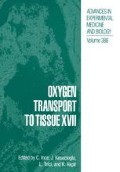Abstract
It is the objective of this paper to describe, what models of oxygen supply, diffusion, and consumption have been and can be used for and to discuss some common problems in employing mathematical models of O2 transport. In a first part, four typical fields for model applications are selected from the wide variety of former investigations and are illustrated with some recent examples.
Access this chapter
Tax calculation will be finalised at checkout
Purchases are for personal use only
Preview
Unable to display preview. Download preview PDF.
References
Batra, S. and Rakusan, K., 1992, Capillary length, tortuosity, and spacing in rat myocardium during cardiac cycle, Am. J. Physiol. 263:H1369–H1376.
Bouwer, S., 1987, Facilitated oxygen diffusion through hemoglobin solutions. Measurement of diffusion and reaction parameters, Doctoral Thesis, University of Nijmegen.
Bruley, D.F., 1995, Empirical modeling for oxygen transport processes and related physiological systems, this volume.
Clark, P.A.A., Kennedy, S.R, and Clark, A., 1989, Buffering of muscle tissue PO 2 levels by the superposition of the oxygen field from many capillaries, Adv. Exp. Med. Biol. 248:165–174.
Egginton, S. and Ross, H.E, 1987, Quantifying capillary distribution in four dimensions, Adv. Exp. Med. Biol. 248:271–280.
Ellis, C.G., Potter, R.F., and Groom, A.C., 1983, The Krogh cylinder geometry is not appropriate for modeling O2 transport in contracted skeletal muscle, Adv. Exp. Med. Biol. 159:253–268.
Federspiel, W.J., 1986, A model study of intracellular oxygen gradients in a myoglobin-containing skeletal muscle fiber, Biophys. J. 49:857–868.
Gayeski, T.E.J, and Honig, CR., 1986, O2 gradients from sarcolemma to cell interior in red muscle at maximal VO 2, Am. J. Physiol. 251:H789–H799.
Gayeski, T.E.J., Connett, R.J., and Honig, CR., 1987, Minimum intracellular PO 2 for maximum cytochrome turnover in red muscle in situ, Am. J. Physiol. 252:H906–H915.
Gayeski, T.E.J., Honig, CR., 1988, Intracellular PO2 in long axis of individual fibers in working dog gracilis muscle, Am. J. Physiol. 254:H1179–H1186.
Groebe, K., 1990, A versatile model of steady state O2 supply to tissue. Application to skeletal muscle, Biophys. J. 57:485–498.
Groebe, K., Erz, S., and Müller—Klieser, W., 1994, Glucose diffusion coefficients determined from concentration profiles in EMT6 tumor spheroids incubated in radioactively labeled 1-glucose, Adv. Exp. Med. Biol, in press.
Hellums, J.D., 1977, The resistance to oxygen transport in the capillaries relative to that in the surrounding tissue, Microvasc. Res. 13:131–136.
Honig, CR., Odoroff, C.L., and Frierson, J.L., 1980, Capillary recruitment in exercise: rate, extent, uniformity, and relation to blood flow, Am. J. Physiol 238:H31–H42.
Honig, CR., Odoroff, CL., and Frierson, J.L., 1982, Active and passive capillary control in red muscle at rest and in exercise, Am. J. Physiol 243:H196–H206.
Hoofd, L., Turek, Z., and Olders, J., 1989, Calculation of oxygen pressures and fluxes in a flat plane perpendicular to any capillary distribution, Adv. Exp. Med. Biol. 248:187–196.
Kayar, S.R., Hoppeler, H., Jones, J.H., Longworth, K., Armstrong, R.B., Laughlin, M.H., Lindstedt, S.L., Bicudo, J.E.P.W., Groebe, K., Taylor, and CR., Weibel, E.R., 1994, Capillary blood transit time in muscles in relation to body size and aerobic capacity, J. Exp. Biol, in press.
Klitzman, B. and Johnson, P.C., 1982, Capillary network geometry and red cell distribution in hamster cremaster muscle, Am. J. Physiol 242:H211–H219.
de Koning, J., Hoofd, L.J.C, and Kreuzer, F, 1981, Oxygen transport and the function of myoglobin, Pflügers Arch. 389:211–217.
Krogh, A., 1918a, The rate of diffusion of gases through animal tissues with some remarks on the coefficient of invasion, J. Physiol (London) 52:391–408.
Krogh, A., 1918b, The number and distribution of capillaries in muscles with calculations of the oxygen pressure head necessary for supplying the tissue, J. Physiol. (London) 52:409–415.
Krogh, A., 1918c, The supply of oxygen to the tissues and the regulation of the capillary circulation, J. Physiol. (London) 52:457–474.
Mathieu—Costello, O., Ellis, CG., Potter, R.F., MacDonald, I.C, and Groom, A.C., 1991, Muscle capillary-to-fiber perimeter ratio: morphometry, Am. J. Physiol. 261:H1617–H1625.
Müller—Klieser, W, 1984, Method for determination of oxygen consumption rates and diffusion coefficients in multicellular spheroids, Biophys. J. 46:343–348.
Potter, R.F. and Groom, A.C., 1983, Capillary diameter and geometry in cardiac and skeletal muscle studied by means of corrosion casts, Microvasc. Res. 25:68–84.
Turek, Z., Hoofd, L., and Rakusan, K., 1987, A comparison of the methods for assessment of the heterogeneity of myocardial capillary spacing, Adv. Exp. Med. Biol. 215:13–19.
Author information
Authors and Affiliations
Editor information
Editors and Affiliations
Rights and permissions
Copyright information
© 1996 Plenum Press, New York
About this chapter
Cite this chapter
Groebe, K. (1996). Practical Applications of Models of Oxygen Supply, Diffusion, and Consumption. In: Ince, C., Kesecioglu, J., Telci, L., Akpir, K. (eds) Oxygen Transport to Tissue XVII. Advances in Experimental Medicine and Biology, vol 388. Springer, Boston, MA. https://doi.org/10.1007/978-1-4613-0333-6_20
Download citation
DOI: https://doi.org/10.1007/978-1-4613-0333-6_20
Publisher Name: Springer, Boston, MA
Print ISBN: 978-1-4613-8002-3
Online ISBN: 978-1-4613-0333-6
eBook Packages: Springer Book Archive

